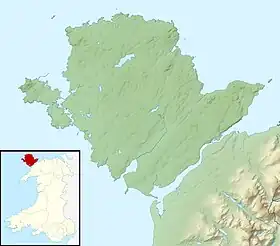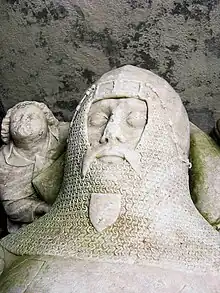Penmynydd
Penmynydd (/pɛnˈmʌnɪð/ pen-MUN-idh,[1] Welsh: [pɛnˈmənɪð] ⓘ), meaning "top of the mountain" in Welsh, is a village and community on Anglesey, Wales. It is known for being the birthplace of the Tudors of Penmynydd, which became the House of Tudor. The population according to the United Kingdom Census 2011 was 465. The community includes the village of Star.
Penmynydd | |
|---|---|
Village | |
 | |
 Penmynydd  Penmynydd | |
| Coordinates: 53.24475°N 4.23442°W | |
| Country | Wales |
| County | Anglesey |
Description
Penmynydd is located on Anglesey off the north west coast of Wales, situated on a slight hill on the B5420 road between Menai Bridge and Llangefni,[2] at grid reference SH510743. The Royal Mail postcode begins LL61 with a community population taken at the 2011 census of 465.[3] Edward Greenly gave the name of the village to the Monian ‘Penmynydd Zone of Metamorphism', a Precambrian blueschist terrane stretching along the hill from Red Wharf Bay to Newborough; the blueschist event has been dated to about 550 million years ago.[4] When Welsh nobleman Rhys ap Tudur was executed in 1412, lands of the Penmynydd family were forfeited.[5] The village is notable for its early 17th century almshouses.[6] The bwthyn at Minffordd was the first place on Anglesey used for Nonconformist worship in the early 18th century,.[7] The village includes the Neuadd Lwyd, a former Victorian rectory that was converted into a country-house hotel.[8] A radio communication transmission mast was installed in 2002 a few yards north of the village at the top of the hill.[9]
The Tudor Family

Penmynydd was the home of the Tudors of Penmynydd, from which sprang the House of Tudor.[2] In the 14th century, a resident of Penmynydd, Tudur ap Goronwy, had five sons, of whom one, Maredudd ap Tudur, was father of the Owen Tudor who joined Henry V of England's army and subsequently established himself at court.[10] After Henry died, his widow, Catherine of Valois, married Owen Tudor in secret around 1429 and had three sons.[11] Their grandson, Henry Tudor, successfully claimed the crown of England, becoming King Henry VII.[12]
The village contains the Grade II* listed building Plas Penmynydd. The house was originally built in 1576 by Richard Owen Tudor, a representative of the senior line of the Tudors of Penmynydd. It was sold following the death of his descendant, another Richard Owen Tudor who had been Sheriff of Anglesey in 1657, and the house passed through several families. It was listed on 2 May 1952.[13] In the 2000s, it was restored by Richard Cuthbertson and featured on the BBC Wales television series Hidden Houses of Wales in 2010.[14]
Governance
The community was part of the Llanfihangel Ysgeifiog electoral ward for elections to the Isle of Anglesey County Council. Following the 2012 Isle of Anglesey electoral boundary changes Penmynydd was transferred to a new multi-councillor ward of Aethwy.
Notes
- Pointon, G. E. (1983). BBC Pronouncing Dictionary of British Names (2nd ed.). Oxford University Press. p. 190. ISBN 0-19-282745-6.
- Hywel Trewyn (21 April 2009), King's Back On His Old Stamping Ground. Post office launches Royal anniversary images, Liverpool Daily Post, p. 8, retrieved 19 November 2013
- "Community population 2011". Archived from the original on 4 March 2016. Retrieved 19 May 2015.
- M. F. Howells, British Regional Geology, Wales, British Geological Survey 2007
- The Welsh Academy Encyclopaedia Wales Extracts The Miners' Next Step, Western Mail (Wales), 15 October 2005, p. 3, retrieved 19 November 2013
- Stuff, Good. "Lewis Rogers Almshouses, Penmynydd, Isle of Anglesey". www.britishlistedbuildings.co.uk. Retrieved 19 April 2018.
- "Cyfarfod y Gwanwyn yn Llangefni" (PDF) (in Welsh). Cymdeithas Treftadaeth y Capeli. 2002.
- Stephen McClarence (24 April 2011), Anglesey is the royal threshold royal threshold, Express on Sunday, archived from the original on 19 November 2013, retrieved 19 November 2013
- Broadband for island, Liverpool Daily Post, 11 November 2002, p. 18, retrieved 19 November 2013
- Nicholas 1872, p. 29.
- Griffiths & Thomas 1985, p. 32.
- "A royal dynasty". BBC Wales. 5 August 2008. Retrieved 21 April 2016.
- "Plas Penmynydd, Penmynydd". British Listed Buildings. Retrieved 26 April 2016.
- "Hidden Houses of Wales visits Plas Penmynydd, Anglesey". BBC North West Wales. 19 January 2010. Retrieved 26 April 2016.
References
- Griffiths, Ralph Alan; Thomas, Roger S. (1985). The Making of the Tudor Dynasty. New York: St. Martin's Press. ISBN 978-0-31250-745-9.
- Nicholas, Thomas (1872). Annals and Antiquities of the Counties and County Families of Wales. Vol. 1. London: Genealogical Publishing.
